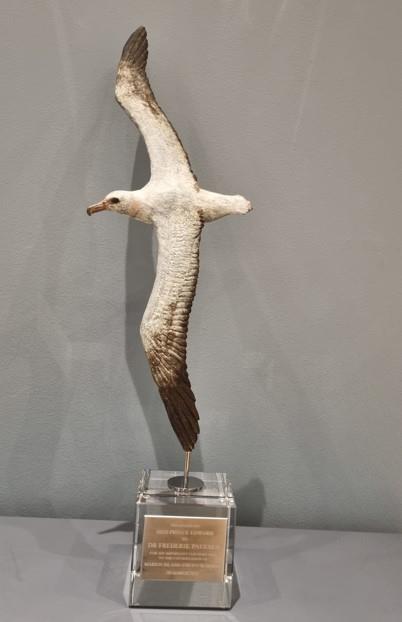PLETTENBERG BAY NEWS – Local sculptor Robbie Leggat has been rubbing shoulders with royalty – not physically, but through his sculpture Wandering Albatross.
Robbie's sculpture was commissioned by BirdLife South Africa for the Mouse-Free Marion (MFM) project, which aims to rid the island of house mice which have become a threat to rare breeding birds like the wandering albatross.
The project was initiated by Birdlife South Africa and the South African Department of Forestry, Fisheries and the Environment.
Wandering Albatross took centre stage in London on 20 March when it was presented by His Royal Highness, the Duke of Edinburgh, the younger brother of King Charles III, to Dr Frederik Paulsen Jr, one of the MFM project's most important benefactors and a director of the MFM board.
This was the first international event of the MFM held at South Africa House in London. The reception was hosted by the South African High Commissioner to the United Kingdom, Jeremiah Nyamane.
It was attended by 80 invited guests including Mark D Anderson, CEO of BirdLife South Africa and chairman of the MFM project management committee.
Namesake
Anderson announced that the duke had "very kindly" agreed to become the royal patron of the project. He noted that Marion Island and the nearby Prince Edward Island together make up the Prince Edward Islands and referred to the duke's love for the natural environment and his commitment to conserving seabirds and other biodiversity.
"It is most fitting that the duke is supporting the MFM project in an island group that was named after his sixth-generation ancestor and namesake, Prince Edward, Duke of Kent and Strathearn (and Queen Victoria's father) by the British explorer Captain James Cook in 1776."
Once completed, the project will restore the critical breeding habitat of over two million seabirds, many globally threatened, and improve the island's resilience in a warming climate.
Happy and relieved
Leggat said it was a very special moment to see the photographs of his sculpture passing through royal hands at the ceremony in London. He said there had been a lot of pressure on him to complete the sculpture and he was "very happy and relieved" to have completed it on time. In creating the sculpture he had used a very old, "tatty" specimen of a wandering albatross as a reference.
He said the project was assisted by Chris Greig of the Charles Greig Gallery in Hyde Park, Johannesburg, in the initial stages.
It could also not have been as successful as it was without the expert knowledge of a number of birders who gave advice.
Leggat is working on further editions of the albatross sculpture series.
Rebounding from predation
Keith Springer, the MFM project's operations manager, in his presentation said, "I've seen first-hand the capacity of island species to rebound from predation.
"Once predatory rodents are removed, the breeding success of seabirds and abundance of invertebrates are quickly evident. This is a once-off intervention and, with the removal of house mice from Marion Island, we can anticipate a rapid improvement in ecosystem functioning. We saw this, for example, on South Georgia, where South Georgia pipits and South Georgia pintails rapidly increased in numbers following the eradication of rats from the island.
"It is now 12 years since the removal of rabbits and rodents from Macquarie Island, and as I observed on a visit there last month, the island is unrecognisable from what it was like in the early 2000s."
 The Wandering Albatross sculpture created by Plettenberg Bay’s Robbie Leggat.
The Wandering Albatross sculpture created by Plettenberg Bay’s Robbie Leggat.

 Robbie Leggat with his life-size sculpture of a wandering albatross and holding the one that was used at the presentation in London - seeing pictures of the occasion made his "heart leap". Photo: Chris van Gass
Robbie Leggat with his life-size sculpture of a wandering albatross and holding the one that was used at the presentation in London - seeing pictures of the occasion made his "heart leap". Photo: Chris van Gass
‘We bring you the latest Garden Route, Hessequa, Karoo news’
















